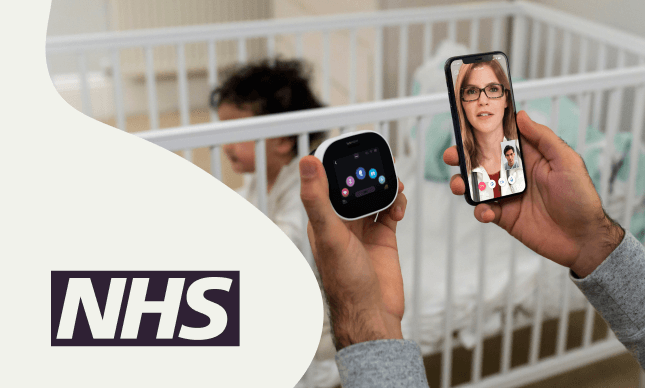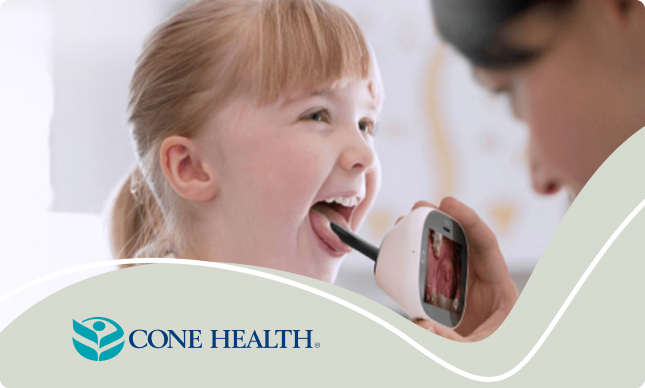Healing from home: NHS virtual wards

What are virtual wards?
Leslie Smith had a stroke and found it a shock to be in Norfolk and Norwich University Hospital overnight. Once he was stabilised, the hospital gave him the chance to join the virtual ward program and continue to receive care from his home within days of his stroke. As Leslie explained, knowing that information from the virtual ward is relayed to the hospital immediately and that he is under continuous remote watch affords him a great sense of security. “The hospital knows what you’re up to, what’s going on with your body, 24 hours a day. There’s nothing to worry about. Just follow the instructions. I thoroughly recommend it. It’s great being home.”
While hospitals offer vital, lifesaving care, what happens to patients who need long-term treatment? Patients who require further monitoring must often stay in the hospital for further observation. But hospitals can be uncomfortable and isolating environments. Virtual wards enable patients to benefit from the physical and emotional comfort that being home can provide. Patients in virtual wards typically receive a home care kit with which they take simple steps to accurately record their vital measurements, such as respiratory rate, blood pressure, temperature, oxygen levels, and pulse while maintaining regular contact with a clinician who will review their data and assess changes over time.
How do virtual wards benefit patients?
Virtual wards allow patients to monitor themselves or be monitored at home. They provide essential information on the patient’s condition and serve as a communication tool for patients to contact medical staff immediately. As one virtual ward patient explained, he found being in the hospital depressing. The lack of socialization, combined with the constant noise and monitors can be difficult to deal with. Being cared for safely and thoroughly from the comfort of home was far preferable in his recovery.
Kenneth Larkins, who received virtual ward care explained how it alleviated his worries without compromising on care quality. He relayed feeling relaxed at home while having medical treatment. Kenneth’s care nurse Janae explained that virtual ward care supports and empowers patients while keeping them out of hospital as much as possible.
Virtual wards can help families of patients to care for them at home as well. In an East Kent NHS virtual ward case study, clinicians found that virtual wards provided hospital-level care at home, which patients like, and allowed them to be closer to family support networks, which can help their recovery. Elizabeth Peerless was treated at Queen Victoria Hospital due to a life-threatening bacterial infection in her hand. After nine days in hospital, Elizabeth required continued wound care at home. Virtual ward monitoring enabled Elizabeth’s daughter to change her dressing and send photos of the wound ahead of Elizabeth’s telephone consultations. The months of physiotherapy that followed were also mainly carried out as video consultations. Elizabeth has since made a good recovery and says she feels that virtual healthcare is the way forward.
How do virtual wards benefit clinicians?
Medical staff are often overtaxed and overwhelmed. Virtual wards allow them to interact face-to-face with patients in a targeted way without being pulled in other directions as so often happens in a hospital setting. Using virtual wards, clinicians are able to instruct patients with very specific directives, such as asking them to do a repeat blood pressure reading and keep track of their medical data over time. The use of technology in digital healthcare enables clinicians to easily collect information on patients’ vital signs as they recover.
Clinicians report high levels of satisfaction with virtual wards. As Sam Higginson of Norfolk and Norwich University Hospitals explained, there have been no incidents of staff sickness on the ward in nine months of operation. The flexibility offered by virtual ward care allows staff to supervise patients even in cases of self-isolation, and improves staff retention rates by encouraging clinical staff to stay on and apply new skills.
Claire Beard, who manages the virtual ward team at the Norfolk and Norwich University Hospital, explains that virtual wards allow staff to see whether any patient variables deteriorate even before patients feel unwell. The NHS is already leaning into digital healthcare to enable clinicians to easily collect information on patients’ vital signs as they recover, and transform the delivery of care and patient outcomes.
With virtual wards, NHS clinicians are able to carry out efficient, meaningful interactions with patients remotely and streamline care. Virtual care allows staff to save high numbers of bed days in physical hospital wards, easing the strain on costs and resources. Patient data provided by virtual wards allows clinicians to increase the number of patients cared for. Clinicians can easily identify which patients need to be readmitted. They are able to identify deteriorating patients before they present dangerous symptoms, which undoubtedly saves lives.
The role of technology
Virtual health tools utilise technology to provide excellent care of patients at home. For instance, in Yorkshire and Humber, TytoCare is transforming remote patient monitoring in the region. Comprehensive monitoring and exam data provide better outcomes in the short and long term. In a 2021 pilot of TytoCare at Bradford Teaching Hospitals, 57% of patients reported that the TytoCare device was easy to use and 43% reported it as very easy to use.
100% of clinicians who used TytoCare said that the technology was easy to use and that it enhanced the care they were able to deliver to patients. According to clinicians, they were able to provide care that would have been difficult to provide otherwise and that it improved patient accessibility to healthcare.
Virtual wards supported by technology enable patients to receive excellent medical treatment from the comfort of home without compromising on care quality. With very high satisfaction rates among patients and clinicians, it’s clear that virtual wards are increasingly becoming an indispensable part of the care offered by the NHS.





